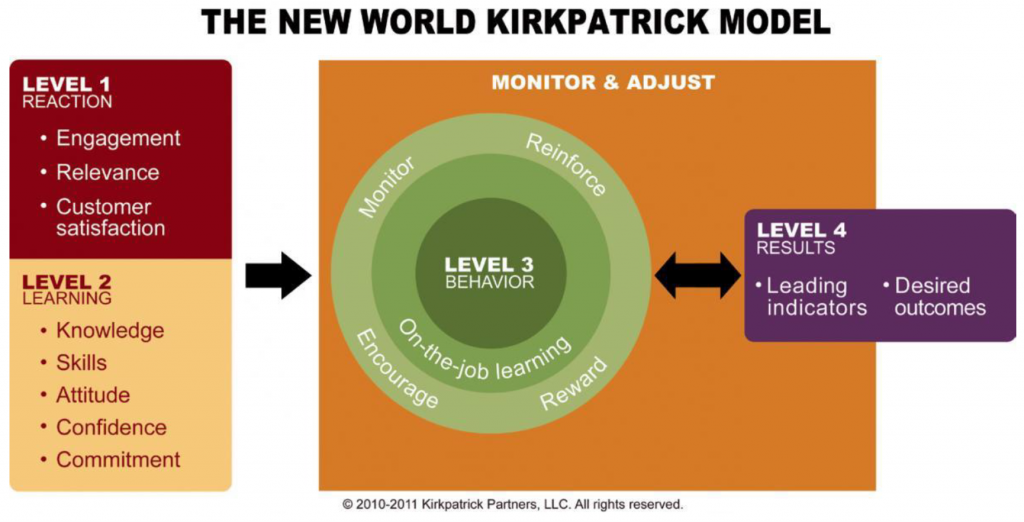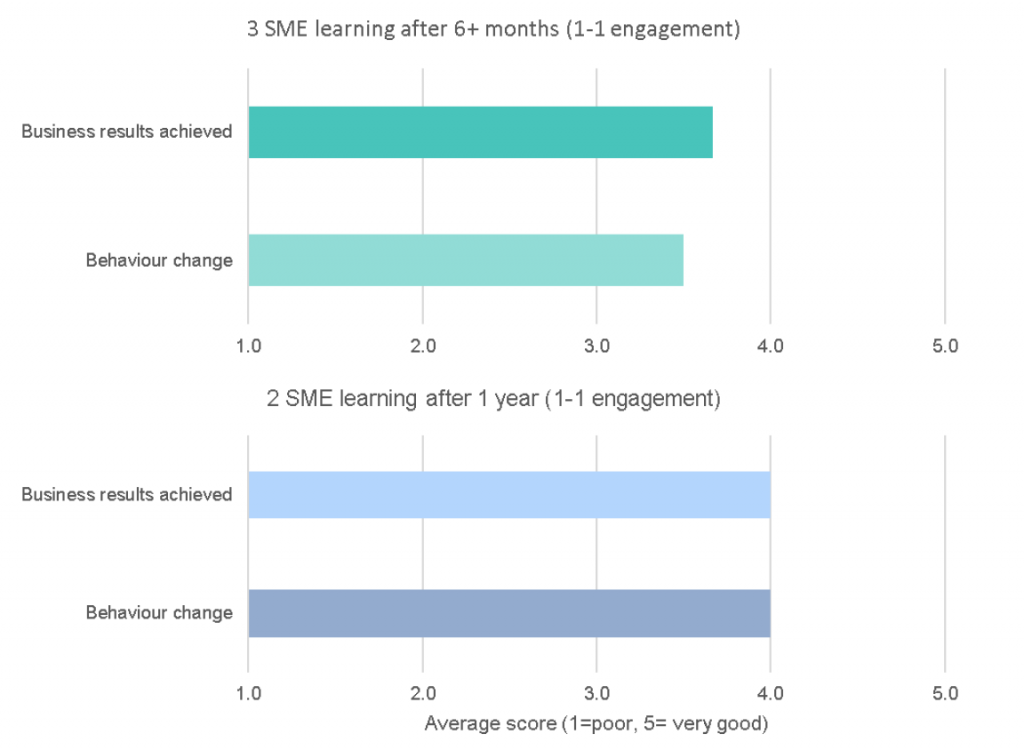Could coaching provide the support that SME’s require to improve their innovation activities? In a pilot 10 SMEs were introduced to strategy and technology management tools developed through research and given coaching on applying these tools to their own processes.
Researchers conclude that direct coaching using university generated knowledge is a form of inbound organizational innovation (OI) and it enables SMEs to improve their innovation activities.
Team training is beneficial in knowledge transfer
Executive coaching is generally considered as a one to one interaction between a coach and a member of the SME management team, however, training is often either in-company involving a larger number of employees or run as open courses involving one or two employees from a range of companies.
The researchers argue that for SMEs – especially when the knowledge to be transferred is broad and strategic in nature – involving a small group of senior executives in workshops that focus on the current situation in the firm, is more aligned to team coaching than group training. As in sport, the members of the management team have different roles to play and knowledge to contribute, and strategy and innovation interventions are likely to be more productive and useful with their inclusion and more likely to promote behavioural change.
The role of the facilitator in coaching continuous improvement in small enterprises, is crucial as the external coaches need to respect the owner-manager’s need of sovereignty and the short-term, “flexible”, style of the small enterprise and to balance this with their role in learning support.
Coaching also supports action learning i.e. using questions to stimulate the development of solutions and actions by participants.
Measuring behavioural change
The Kirkpatrick (1994) model is widely used in the training world to measure the impact of training by way of measured change in behaviour and business results.
The 4 levels work as follows see figure below:
Level 1: Reaction – to what degree participants react favourably to the learning event
Level 2: Learning – to what degree participants acquire the intended knowledge, skills and attitudes base on their participation in the learning event.
Level 3: Behaviour – to what degree participants apply what they learned during training when they are back on the job
Level 4: Results – to what degree targeted outcomes occur, as a result of the learning event(s) and subsequent reinforcement
Levels 1 and 2 are essentially the ‘feedback sheets’ done at the end of a course. Levels 3 and 4 are longer term and happen when the participants return to the workplace. Some of the types of questions look at knowledge before and after or ask participants to score their confidence in using something themselves or teaching others about it.
From every coaching or training workshop there is a level of learning that comes from it and a level of willingness (or ability) to action the output for a defined business result (or impact). The thinking with the Kirkpatrick model is that you start with the end in mind as part of developing training. i.e. what improvement do you want, therefore what difference in behaviour, attitude, skills do you need, therefore what is the nature of the coaching, training or development you need, which defines the coaching interaction or training course.

Knowledge transfer of technology management tools through one-to-one coaching
The pilot involved working with 10 SMEs to explore and map knowledge transfer in the form of direct one to one coaching engagements from academia to industry and comparing this with an open course.
The SME’s were introduced to four main tools – Prioritisation, Strategy, Marketing planning, Portfolio selection and Roadmapping – and given support to apply them within their own organisations.
- Prioritisation tool: This identifies business priorities and analyses performance across the business by means of interviews with senior managers and functional leaders. The findings are presented at a workshop and reviewed in detail with the management team. These results are graphically represented and easy to understand, providing a powerful communication tool which helps to build communication and consensus across the business and enables managers to compare their priorities with their colleagues.
- Strategy tool: This fast and effective approach to business strategy development results in a clear vision for the future of the business, a shared understanding of which markets and product groups to focus on, the competitive position within those markets and a prioritised set of capability development projects. The process has four key steps, using a structured yet creative approach to generate and review ideas leading to the identification of clear strategic options and a shared ownership of – and commitment to – the direction the company should take.
- Marketing planning tool: This helps companies take a systematic approach to market analysis and strategic marketing planning, and the allocation of resources and activities. This is achieved by taking a modular approach that breaks down the process into manageable components that can be combined and configured to the business’s requirements.
- Portfolio selection tool: This provides a company with a standard set of criteria for ranking projects and selecting an appropriate portfolio. The criteria, grouped broadly into ‘opportunity’ criteria and ‘feasibility’ criteria, are customised during a workshop for a company based on its circumstances. This can then be used to compare projects and plan a way forward.
- Roadmapping: This is a powerful technique that has become integral to creating and delivering strategy and innovation in many organisations. The graphical and collaborative nature of roadmaps supports strategic alignment and dialogue between functions in the firm and between organisations. The power of roadmapping lies in its flexibility, which can provide clarity and alignment of specific needs at all levels, including functional, organisation-wide and even collaboration between organisations.
Results – Direct coaching effective for knowledge transfer
The pilot identified the role of the following aspects that contributed to effective coaching of SMEs: the way knowledge is packaged (the tool), the knowledge transfer process, and the facilitator. This is done by comparing scores from coaching with scores from open courses. This resulted in positive changes in behaviour and results.

Key learning points
Recommendations for the knowledge transfer process
- Package academic knowledge to user friendly tools and time-efficient processes (this needs to be typically within 1 day or less maximum per engagement).
- Provide reflection time for refinement and alignment before decisions are made.
- Eliminate academic jargon from interaction with SMEs.
- Select knowledgeable facilitators who combine both industrial and academic experience.
- Engage participants into the process e.g. providing data, analysing information, using the tools and making decisions, etc.
- Explain in advance what output is expected, in what format and within what time frame and manage expectations.
Benefit for RTOs when applying the approach of this pilot
- Easy to organise engagement (most SMEs do not require NDAs, framework agreements and complicated legal contracts).
- Access to a large number of companies.
- Can develop deeper understanding of industrial needs quicker.
- Can test and validate academic models and tools faster.
Benefit for academics when applying the approach of this pilot
- Enhance their knowledge about innovation management.
- Access to a large number of companies that could be used as case studies.
Benefit for SMEs when applying the approach of this pilot
- Custom-made and focused improvement plans address their specific needs.
- Grow their business without increasing costs.
- Focus on real growth (jobs and revenues) rather than just productivity output
Read the full paper
Acknowledgements
This work is funded and supported by the EU Science2Society programme.
The contribution of the IfM ECS facilitators involved in carrying out the pilot workshops (Duncan Hurlestone, Derek Ford, Michele Routley and Liz Salter) and IfM research colleagues in shaping and guiding the project (Amanda Bamford,Serena Flammini and Thomas Coates Ulrichsen) are gratefully acknowledged.
Related reading
Ahn, J. M., L. Mortara and T. Minshall. 2013. “The effects of open innovation on firm performance: a capacity approach.” Science, Technology and Innovation Policy Review 4 (1), 74-93. http://www.stipolicyreview.net/
Chesborough, H. 2003. Open Innovation. HBS Press, Boston Mass.
Fabrizio, K.R. 2009. “Absorptive capacity and the search for innovation.” Research Policy 38:255-267.
Farrukh, C., C.Kerr, R.Phaal, N.Athanassopoulou and M.Routley. (2014). “Light-weighting innovation strategy: a roadmap-portfolio toolkit.”Proceedings of the Portland International Conference on Management of Engineering and Technology (PICMET), Kanazawa, 27-31 July.
Farrukh, C., N.Athanassapoulou, R.Phaal, and F.Tietze. 2015. “SME innovation practice and needs: lessons from the PrISMS Programme.” R&D Management Conference, Pisa, Italy.

